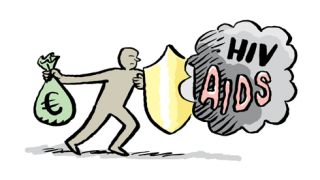World AIDS Day, 1st December 2021

The HIV/AIDS epidemic of previous decades has presented governments and development workers, particularly those in the Global South with major challenges. There are currently 30 million people living with HIV. A report by UNAIDS indicated that, in 2019, 1.7 million people were newly infected with HIV and 690,000 died from AIDS-related illnesses. Important gains in the most affected regions of sub-Saharan Africa and the Caribbean have been counterbalanced by rising epidemics in Latin America, eastern Europe and central Asia, and the Middle East and North Africa.
Impact of Covid-19
Covid-19 has presented even greater challenges for developing countries struggling to deal with the epidemic of HIV and AIDS as health systems already under strain had no resource capacity to tackle the new pandemic. The UNAIDS Report advocates for a person-centred response to HIV/AIDS, utilising learning from the Covid-19 response. Such a response would include:
- HIV Services proven to prevent HIV infections or AIDS-related mortality.
- Societal enablers to include laws and policies, and societies that respect gender equality and do not discriminate against PLHIV and key populations.
- Service enablers which include the linkage or integration of services, differentiated service delivery and community-led services.
- System enablers to include infrastructure, strategic planning, budgeting and management systems, monitoring and evaluation system and communications systems.
- Development synergies across a range of sectors.
HIV / AIDS in Ireland
- The Health Protection Surveillance Centre (HPSC) indicates that there were 449 notifications of HIV infection in Ireland in 2020, a national notification rate of 9.4 per 100,000 of the population in 2020.
- There were 322 notifications of HIV for the first 45 weeks of 2021, a decrease of 75 notifications on the same period in the previous year. The majority of case notifications came from the Eastern Region (228), followed by the North-East (22) and South (16).
- The age group with the highest incidence of HIV for the first 45 weeks of 2021 was those aged 30-34 (72), followed by those aged 35-39 (59), 25-29 (56). Meaning that almost 3 in 5 noticiations (58 per cent) came from people aged 25-39. At either end of the age spectrum, 4 notifications were recieved in respect of people aged 15-19 and 11 notifications were received in respect of people aged 60+.
- Males accounted for 253 notifications (79 per cent), while Females accounted for 63 (20 per cent) (with a further 5 Unknown and 1 Not Specified).
Crucial Window
At their event in July 2021, entitled 'The Final Countdown: Reflections on 40 years of HIV, It’s A Sin and AIDS and how we can end new HIV transmissions by 2030', HIV Ireland urged Government not to miss the "crucial window" of opportunity to address HIV and AIDS in Ireland, calling for increased investment in free, accessible, peer-led community-based testing services, greater investment in prevention of HIV and AIDS, and investment to eliminate the stigma surrounding these diagnoses.
The HIV Ireland Annual Report 2020, published in November 2021, also noted an increase in people living with HIV seeking advocacy services and counselling supports.